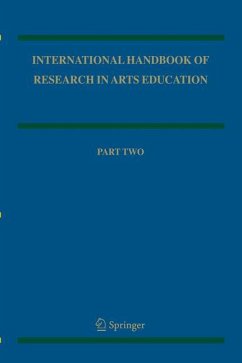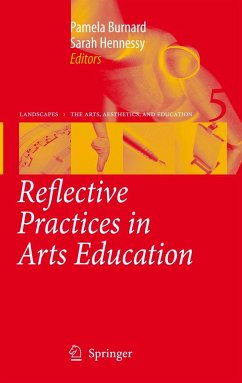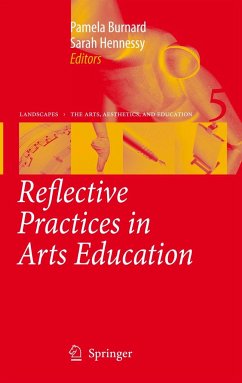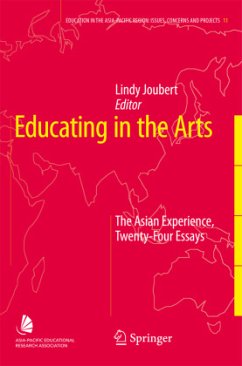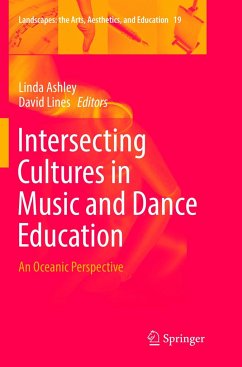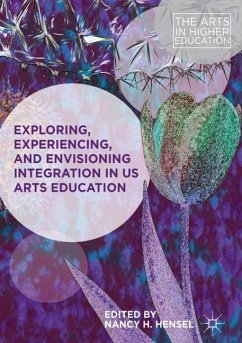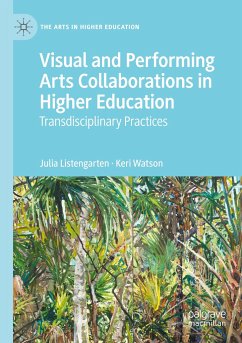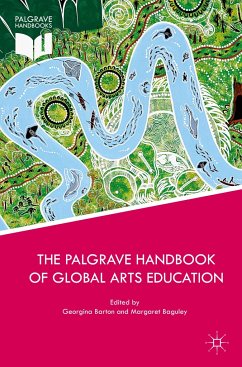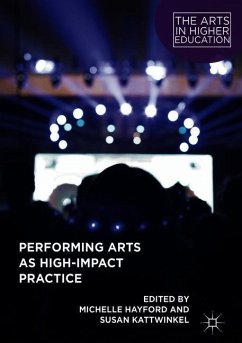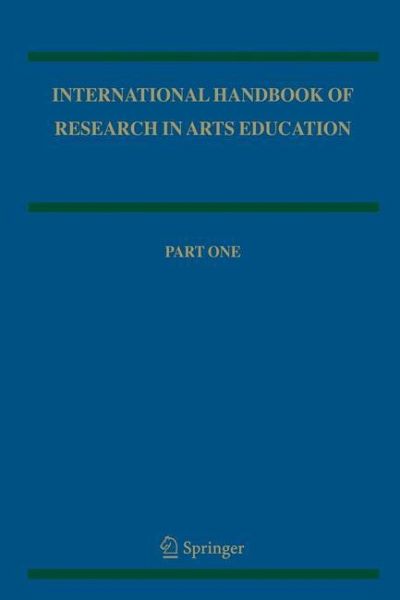
Liora Bresler (ed.)
Gebundenes Buch
International Handbook of Research in Arts Education
Versandkostenfrei!
Versandfertig in 1-2 Wochen
Weitere Ausgaben:

PAYBACK Punkte
210 °P sammeln!





Providing a distillation of knowledge in the various disciplines of arts education (dance, drama, music, literature and poetry and visual arts), the Handbook synthesizes existing research literature, helps define the past, and contributes to shaping the substantive and methodological future of the respective and integrated disciplines of arts education. While research can at times seem distant from practice, the Handbook aims to maintain connection with the lived practice of art and of education, capturing the vibrancy and best thinking in the field of theory and practice.The Handbook is organ...
Providing a distillation of knowledge in the various disciplines of arts education (dance, drama, music, literature and poetry and visual arts), the Handbook synthesizes existing research literature, helps define the past, and contributes to shaping the substantive and methodological future of the respective and integrated disciplines of arts education. While research can at times seem distant from practice, the Handbook aims to maintain connection with the lived practice of art and of education, capturing the vibrancy and best thinking in the field of theory and practice.
The Handbook is organized into 13 sections, each centering on a major area or issue in arts education research. These areas include: History of arts education, curriculum, evaluation, cultural centers, appreciation, composition, informal learning, child culture, creativity, the body, spirituality, and technology. The individual chapters address cross-cultural research related to the central theme of the section from the perspectives of the particular arts discipline. Interludes provide reflective thoughts on the theme.
The Handbook is organized into 13 sections, each centering on a major area or issue in arts education research. These areas include: History of arts education, curriculum, evaluation, cultural centers, appreciation, composition, informal learning, child culture, creativity, the body, spirituality, and technology. The individual chapters address cross-cultural research related to the central theme of the section from the perspectives of the particular arts discipline. Interludes provide reflective thoughts on the theme.
L. Bresler, University of Illinois at Urbana-Champaign, USA
Produktdetails
- Springer International Handbooks of Education Vol.16
- Verlag: Springer Netherlands
- Artikelnr. des Verlages: 11334002
- 2007
- Seitenzahl: 1676
- Erscheinungstermin: 26. Januar 2007
- Englisch
- Abmessung: 241mm x 160mm x 100mm
- Gewicht: 3226g
- ISBN-13: 9781402029981
- ISBN-10: 1402029985
- Artikelnr.: 20891620
Herstellerkennzeichnung
Springer-Verlag GmbH
Tiergartenstr. 17
69121 Heidelberg
ProductSafety@springernature.com
Review in Arts and Learning Research Vol 23:1
The International Handbook of Research in
Arts Education
Bresler, L. (Ed.). (2007)
Dordrecht, NL: Springer. 1627 pp.
ISBN 978-1-4020-2998-1
$549 Hardcover
Reviewed by Jessica Hoffmann Davis
Independent Scholar
If you've ever observed a two-year old child drawing with
colorful markers on an endless stretch of paper (the blank side
of wrapping or wallpaper will do), you may decide that it's very
dif.cult to pinpoint exactly what she is doing. For sure she is
making marks (exploring the boundaries of media) like a visual
artist, but when the rhythm of the tapping of the
The International Handbook of Research in
Arts Education
Bresler, L. (Ed.). (2007)
Dordrecht, NL: Springer. 1627 pp.
ISBN 978-1-4020-2998-1
$549 Hardcover
Reviewed by Jessica Hoffmann Davis
Independent Scholar
If you've ever observed a two-year old child drawing with
colorful markers on an endless stretch of paper (the blank side
of wrapping or wallpaper will do), you may decide that it's very
dif.cult to pinpoint exactly what she is doing. For sure she is
making marks (exploring the boundaries of media) like a visual
artist, but when the rhythm of the tapping of the
Mehr anzeigen
mark-making on
paper inspires her to jump a little as she sits or now to hop/crawl
across the paper, she seems more like a dancer exploring some
haiku-like choreography; and when the words tumble like musical
notes in chant-like accompaniment to the motion-"Bbbbbbb,
up!"- you are not sure if what you are witnessing is drawing,
modern dance or music, spoken word poetry, performance or even
ritual art. The International Handbook of Research in Arts Education is
a lot like that. But don't worry, it sets out to be.
From the start, editor Liora Bresler points to the soft edges of
disciplines and the boundary crossing that invites, setting the stage
for a research tome that spans the artistic disciplines of music, dance,
visual arts, and writing, including voices from different academic
and geographical locations that travel on their own or intertwined
within and across a variety of themes. But don't be misled by the
playful tone of my opening metaphor. The International Handbook of
Research in Arts Education marks a substantive contribution to the
literature on the arts in education and it is chock full of thoughtful,
well documented reviews anddiscussions of past and current
research-research that spans scholarship in aesthetics and arts
in education as well as anthropology, cultural psychology, and
curriculum theory. Beyond its reach in terms of artistic disciplines
and scholarly realms, however, the Handbook is in itself a boundary
breaker defying expectation in both content and form.
In comparison with the Handbook of Research and Policy in
Art Education, edited by Elliot Eisner and Michael Day in 2004, a
milestone in advancing the .eld of visual art education as informed
by serious research and re.ection, Bresler's International Handbook
expands the landscape by: 1) taking a multi-arts perspective, and
counting creative writing in the mix; 2) inviting contributors to
engage openly in dialogue; 3) including contributions of unexpected
format; and 4) attempting if not overtly then at least implicitly to
function in itself as a work of art. While Eisner and Day play by
the rules producing an impressive compendium of scholarship for
a .eld that may have been thought unscholarly, Bresler breaks the
rules by challenging the standard constraints of such a volume.
While Eisner and Day conscientiously frame the .eld of visual art
education with the expected fences of history, policy, learning,
teaching, assessment, and a view of a future in the making, Bresler
and her team of 15 section editors honor these hurdles even as they
cross them and brave the unexpected beyond.
The thirteen sections of the book, comprised of contributions
from 116 authors, are organized within and across the porous
territorial boundaries of context (history; technology; museums
and cultural centers; informal learning; child culture; social and
cultural issues) and content (curriculum; evaluation; composition;
appreciation; the body; creativity; and spirituality).Section editors
begin their segments with a prelude that explicates the topic and
the themes that emerge from the writings of individual or pairs
of authors who focus on particular art disciplines. International
Handbook Advisory Board members add commentaries related
to these individual contributions from the perspectives of the 35
countries they represent. Unexpected in a compendium of this
kind are the "expressive" interludes that punctuate the pace with
artful personal re.ection, provocative ruminations, poetry, and/
or individual authors' responses to other authors' contributions.
Visual renderings of what appear to be montages of stone add
metaphoric cadence to the section breaks, challenging their
deliberately porous division.
The contributors are an exciting group of scholars and
practitioners, representing a range of disciplines and destinations.
As examples from the international cast, there's Peter Abbs from the
United Kingdom (writing); Rita L. Irwin and F. Graeme Chalmers
from British Columbia (visual arts); Shifra Schonmann from
Israel (drama); Regina Murphy from Ireland (music); and Minette
Mans from Namibia (performing arts). On the North American
front there are the "giants" in the .eld such as Elliot Eisner and
Arthur Elfand (visual arts), Bennett Reimer (music), and Elizabeth
Vallance (museums); veteran arts education scholars who challenge
traditions including Elizabeth Garber; newer voices forging
the future such as Kim Powell and Lissa Soep; and well-known
scholars across academic disciplines including Ellen Dissanayake
and Nel Noddings. Editor Liora Bresler was so intent on .lling
out her star-studded troupe (what she calls her "dream team" for
the Handbook) that she even included (at his suggestion) personally
recorded arts encounter snippets from her e-mailcorrespondence
with Professor Jerome S. Bruner, who was otherwise unavailable
to make a contribution.
As a thread woven through all sorts and many of the pieces of
the whole of this work, the resonant voice of philosopher Maxine
Greene serves as inspiration and ballast to author contributions
whether she is speaking to issues of the arts as agents to awakening
imagination or to exciting social justice. Just as Tom Barone dedicates
his curriculum essay to his second and third grade teacher: "In the
beginning there was Light and she was named Mrs. Eddy"(p. 239).
Robert Stake constructs his interlude as an admiring response to
Greene's powerful Handbook re.ection on appreciation (p.665).
Evoking Harry Broudy's notions of "enlightened cherishing," Stake
considers the challenge of translating into classroom practice the
transcendence of the "taken for granted" that Greene sees as an
"end-in-view for aesthetic education"(p. 665).
In experiencing the cross-referencing that persists through
the Handbook, we are aware, as we are with a work of art, of the
process that went into the creation of this product. Stake takes
fellow contributor Greene as inspiration; Arthur E.and defends
".ne art" from the limitations of political neutrality placed upon it
by fellow contributor Paul Duncum. Interludes speak across voices;
preludes speak across themes. The International Advisory Board
members use as touchstones for their descriptions of arts education
in their respective countries the domain speci.c research presented
mainly, but with notable exceptions, by scholars from North
American universities. This lively discourse across contributor and
contribution lends coherence to the broad range of treatises and
perspectives included in the work, even as a lack of clear boundaries
among topics challenges theinternal cohesiveness of some of the
different sections.
Artistic symbols are distinguished by the ambiguity that opens
them to multiple interpretations. The ambiguity of the edges of its
various sections may be another way in which the Handbook is like a
work of art, but it adds considerable challenge to the work of section
editors and contributors. Section editor Susan Stinson in her prelude
to the section on curriculum explains: "... determining boundaries
has been a challenge for all authors of the Handbook...[as] re.ected
in many of the questions that circulated through the cyber-process
of this project: 'What counts as research?' 'What educational
research is not about curriculum?' 'How can one adequately
contextualize this research without describing its history, which is a
separate section of the Handbook?'"(p. 143). In part as a consequence
of this "boundary bleeding" (and of course because many of the
contributors to this text are artists themselves) we .nd the authors,
like artists, braving hard fundamental questions: "What is the real
question?" "What gets included and what gets left out?" "How
do I create an aesthetic whole that usefully embraces but does not
pretend to de.nitively contain the topic at hand?" The behindthe-
scene view of authors in conversation, sharing challenges in
the framing of their individual contributions or being inspired in
their writing by each other's work increases the immediacy of this
dynamic presentation of scholarship.
In his interlude in the section on evaluation, Chris Higgins
takes issue with the assertion that "Research is objective; art is
subjective. Research discovers; imagination invents" (p. 393).
Alternatively, drawing on Dewey's claim that the arts teach us
to see more, Higgins proposes that, "like the best artists, thebest
researchers use their imagination to move past the cardboard
versions of things. The question for educational evaluation is not
which method to choose or how to employ it, but how to notice...the
dimensions of classrooms that are hiding in plain view" (p. 393).
Like other contributions in the Handbook there is no apology here
for the arts not being up to the clear edge-cutting of scienti.c
research; no attempt to limit the knowledge of the .eld to the crisp
compartments that arguably serve other areas well. The focus
here is on seeing more clearly, as artists do, "beyond the taken for
granted" to what the arts in education in particular provide, those
invaluable variables that may be "hiding in plain view."
While the authors I've mentioned point to the dif.culty of
adhering to established boundaries even in the most straight forward
section topics (history, curriculum, evaluation, appreciation,
technology, museums and cultural centers) those topics more
overtly open to idiosyncratic interpretation (informal learning,
child culture, social and cultural issues, creativity, the body, and
spirituality) invite even broader brush strokes. Minette Mans
attempts to clarify the spectrum of learning experiences that can
be included in the category of informal learning: "The spectrum
of learning experiences can range from accidental, unintentional,
or reluctant forms of learning to active, intentional, involved and
highly valued forms of learning" (p. 779). Introducing their section
on social and cultural perspectives in arts education, Douglas
Risner and Tracie Costantino speak to the breadth of their topic:
"the enormity of social issues in arts education spans tremendous
global research terrain" and to its overlap with other sections in
the Handbook, "social issues permeate the educational fabricof
curriculum, history, evaluation, the body, and technology" (p. 941).
This section, which addresses fascinating recent research studies,
.nds a measure of uni.cation, Risner and Costantino tell us, in a
focus on justice and freedom (here again after Maxine Greene).
But within the bristles of broad brush strokes lie issues that easily
could each have had their own sections: gender, identity, diversity,
social justice, critical pedagogy.
Adopting the two-year-old's haiku choreography, let me piece
together a collage of points of interest. The section on composition
most interestingly addresses both the issues of how artists compose
in different domains and how we teach students to compose. The
theme of metaphor features large in that section and is gracefully
addressed in interludes by Keith Swanwick and Michael Parsons.
The section on museums and cultural centers rightly includes an
interlude by David Carr on the role of libraries. The section on
child culture attends to the voice, vision, and values that children
bring into class and that can be recognized, honored, ignored, or
even exploited. The section on body is heavy on mind, replete
with philosophical overtone and reference, addressing learning
and art making through the senses, the extent to which the body
is represented in art, and the challenge of resolving the mind body
problem with concepts like "embodied minds."
The last section of the Handbook is on spirituality and it is
perhaps the bravest section of all. Conversations of how we educate
our soul are conspicuously absent in mainstream educational
discourse and they feel rare and strange in a .nal chapter that
would have been expected to hold no new surprise. Section editor
Rita L. Irwin speaks of "a longing for the spiritual" that holds steady
amidst moving educational trends.She describes the education of
soul: "An education of the soul is an education .lled with feeling
completely alive, being at one with the universe while experiencing
joy, compassion, mindfulness, and a sense of awe for the mystery
that abounds" (p. 1401). But discussions of "feeling completely
alive" like the idea of a curriculum that "moves beyond rational
and analytic ways of understanding to intuitive and emotional
ways of knowing" (p. 1401) do not lend themselves to standard
academic discourse. The problem one is convinced at this juncture is
not with the scope of the topic, but with the limitations of academic
discourse. Broader vocabularies and multiple modes of expression
(like the story telling and poetry these authors employ) are needed
to facilitate conversations about what matters most. Regretting
that there is painfully little if any research literature around an
art education that is grounded in spirituality, in this grand .nale
contributors declare its importance and launch a call for attention.
As London puts it, "Then, be it resolved, something ought to be
done about this. Soon" (p. 1492).
I was privileged to work for years in my teaching with a diverse
group of students-non-arts classroom teachers, arts teachers,
museum educators, program of.cers, community arts educators
and administrators-most of them sharing a predisposition for
and/or training in artistic activity and all of them uni.ed by a
belief in the importance of the arts in education. Actors, musicians,
painters, sculptors, poets, writers-all together in my classroom,
confronting common themes from their different perspectives.
And it would happen every fall. The drama or dance or visual arts
teacher would stand up and say, "Well, I can't speak for music
or writing-I wouldn't dare-but in my classes, I.nd...." And I
would ask, "if you wouldn't dare to speak across artistic domains
to another teacher of the arts, how on earth are you going to dare
to speak to a science teacher about what it is you do?"
Discourse across artistic domains is essential to our forging
educational conversations across arts and non-arts domains. We
must cross boundaries; and we must make sense of the boundary
crossing. If I wanted more from the International Handbook of Research
in Arts Education, it was in this regard. I wanted more about the
similarities and differences in metaphor's structure in language,
dance, visual arts or music; more about what music education in
Indiana can learn from music education in Ireland. I wanted the
scholars in this volume to move like spidermen and women and
do more web weaving out of the bounty of diverse artistic and
international perspectives. But I am impatient and I also realize
that like any work of art, the Handbook asks much of the reader by
way of interpretation and sense making. Had I had this volume in
my classes, I could have asked my students to use it as a source in
the spidering they will need to do.
Bresler's International Handbook of Research in Arts Education is
a sprawling and ambitious enterprise, rightly called by Bresler a
"huge mosaic." By bringing together scholars from different artistic
disciplines and locations, it initiates a conversation that speaks of
and to a burgeoning promising modern and timeless conception
of a .eld called the arts in education. That conversation, as I have
tried to describe and demonstrate, is made up of voice and inquiry,
struggle and triumph, diversity and direction, scholarship and
communication, artistry and rigor, blurred boundaries, overarching
themes, and sharp tips of icebergs tweaking complacency and
invitingfurther research and discourse. I congratulate Liora
Bresler and her star-studded dream team. The territories to which
they take us (even those we thought we knew) are complex and
compelling.
Like the two year old's multifaceted activity, the Handbook
is not about visual arts, dance, drama, or music; it is about
all of them because those activities, as they do in the vibrant
activity of the young child as artist, overlap, inform, enrich and
rede.ne each other. And as it is with the two year-old's drawing,
doubters will look to this multifaceted Handbook and question the
integrity of the activity, liken my admiration for the work to the
romantic's cross-disciplinary interpretation of what is only the
aimless scribbling of the young child. Doubters will fault Bresler
for not pulling in the reigns and making her compilation of arts
education scholarship look more like what is done in handbooks for
mainstream disciplines. But I applaud this work as precisely the sort
of uncompromising high holding of the head that arts education
deserves and I will cite the International Handbook of Research in Arts
Education as a model of what the arts do of which other disciplines
need to do more. I recommend this text to any student of the arts
in education and I suggest for their journeying forth they hold on
to their hats in readiness for the boundary leaping and exploration
of emotion this rigorous treatise daringly pursues.
Reference
Eisner, E. & Day. M. (Eds.). (2004). Handbook of research and policy in art
education. A Project of the National Art Education Association.
New Jersey: Lawrence Erlbaum.
Jessica Hoffmann Davis is the author of Framing Education as Art:
The Octopus has a Good Day (2005). At Harvard University, Dr. Davis
founded and was the .rst director of the Graduate School ofEducation's
Arts in Education Program and held the university's .rst chair in the arts
in education. Her new book, on advocating for the arts in schools, will be
published in 2007 by Teachers College Press.
From the reviews:
"International Handbook of Research in Arts Education, editor Liora Bresler set out to identify research agendas and issues across the arts and to define a new relationship among disciplines that are naturally related outside of the academy. ... Bresler and her section editors and authors have given the arts professions and academies an astounding work of high artistic and intellectual merit." (Marie McCarthy, British Journal of Music Education, Vol. 26 (3), 2009)
paper inspires her to jump a little as she sits or now to hop/crawl
across the paper, she seems more like a dancer exploring some
haiku-like choreography; and when the words tumble like musical
notes in chant-like accompaniment to the motion-"Bbbbbbb,
up!"- you are not sure if what you are witnessing is drawing,
modern dance or music, spoken word poetry, performance or even
ritual art. The International Handbook of Research in Arts Education is
a lot like that. But don't worry, it sets out to be.
From the start, editor Liora Bresler points to the soft edges of
disciplines and the boundary crossing that invites, setting the stage
for a research tome that spans the artistic disciplines of music, dance,
visual arts, and writing, including voices from different academic
and geographical locations that travel on their own or intertwined
within and across a variety of themes. But don't be misled by the
playful tone of my opening metaphor. The International Handbook of
Research in Arts Education marks a substantive contribution to the
literature on the arts in education and it is chock full of thoughtful,
well documented reviews anddiscussions of past and current
research-research that spans scholarship in aesthetics and arts
in education as well as anthropology, cultural psychology, and
curriculum theory. Beyond its reach in terms of artistic disciplines
and scholarly realms, however, the Handbook is in itself a boundary
breaker defying expectation in both content and form.
In comparison with the Handbook of Research and Policy in
Art Education, edited by Elliot Eisner and Michael Day in 2004, a
milestone in advancing the .eld of visual art education as informed
by serious research and re.ection, Bresler's International Handbook
expands the landscape by: 1) taking a multi-arts perspective, and
counting creative writing in the mix; 2) inviting contributors to
engage openly in dialogue; 3) including contributions of unexpected
format; and 4) attempting if not overtly then at least implicitly to
function in itself as a work of art. While Eisner and Day play by
the rules producing an impressive compendium of scholarship for
a .eld that may have been thought unscholarly, Bresler breaks the
rules by challenging the standard constraints of such a volume.
While Eisner and Day conscientiously frame the .eld of visual art
education with the expected fences of history, policy, learning,
teaching, assessment, and a view of a future in the making, Bresler
and her team of 15 section editors honor these hurdles even as they
cross them and brave the unexpected beyond.
The thirteen sections of the book, comprised of contributions
from 116 authors, are organized within and across the porous
territorial boundaries of context (history; technology; museums
and cultural centers; informal learning; child culture; social and
cultural issues) and content (curriculum; evaluation; composition;
appreciation; the body; creativity; and spirituality).Section editors
begin their segments with a prelude that explicates the topic and
the themes that emerge from the writings of individual or pairs
of authors who focus on particular art disciplines. International
Handbook Advisory Board members add commentaries related
to these individual contributions from the perspectives of the 35
countries they represent. Unexpected in a compendium of this
kind are the "expressive" interludes that punctuate the pace with
artful personal re.ection, provocative ruminations, poetry, and/
or individual authors' responses to other authors' contributions.
Visual renderings of what appear to be montages of stone add
metaphoric cadence to the section breaks, challenging their
deliberately porous division.
The contributors are an exciting group of scholars and
practitioners, representing a range of disciplines and destinations.
As examples from the international cast, there's Peter Abbs from the
United Kingdom (writing); Rita L. Irwin and F. Graeme Chalmers
from British Columbia (visual arts); Shifra Schonmann from
Israel (drama); Regina Murphy from Ireland (music); and Minette
Mans from Namibia (performing arts). On the North American
front there are the "giants" in the .eld such as Elliot Eisner and
Arthur Elfand (visual arts), Bennett Reimer (music), and Elizabeth
Vallance (museums); veteran arts education scholars who challenge
traditions including Elizabeth Garber; newer voices forging
the future such as Kim Powell and Lissa Soep; and well-known
scholars across academic disciplines including Ellen Dissanayake
and Nel Noddings. Editor Liora Bresler was so intent on .lling
out her star-studded troupe (what she calls her "dream team" for
the Handbook) that she even included (at his suggestion) personally
recorded arts encounter snippets from her e-mailcorrespondence
with Professor Jerome S. Bruner, who was otherwise unavailable
to make a contribution.
As a thread woven through all sorts and many of the pieces of
the whole of this work, the resonant voice of philosopher Maxine
Greene serves as inspiration and ballast to author contributions
whether she is speaking to issues of the arts as agents to awakening
imagination or to exciting social justice. Just as Tom Barone dedicates
his curriculum essay to his second and third grade teacher: "In the
beginning there was Light and she was named Mrs. Eddy"(p. 239).
Robert Stake constructs his interlude as an admiring response to
Greene's powerful Handbook re.ection on appreciation (p.665).
Evoking Harry Broudy's notions of "enlightened cherishing," Stake
considers the challenge of translating into classroom practice the
transcendence of the "taken for granted" that Greene sees as an
"end-in-view for aesthetic education"(p. 665).
In experiencing the cross-referencing that persists through
the Handbook, we are aware, as we are with a work of art, of the
process that went into the creation of this product. Stake takes
fellow contributor Greene as inspiration; Arthur E.and defends
".ne art" from the limitations of political neutrality placed upon it
by fellow contributor Paul Duncum. Interludes speak across voices;
preludes speak across themes. The International Advisory Board
members use as touchstones for their descriptions of arts education
in their respective countries the domain speci.c research presented
mainly, but with notable exceptions, by scholars from North
American universities. This lively discourse across contributor and
contribution lends coherence to the broad range of treatises and
perspectives included in the work, even as a lack of clear boundaries
among topics challenges theinternal cohesiveness of some of the
different sections.
Artistic symbols are distinguished by the ambiguity that opens
them to multiple interpretations. The ambiguity of the edges of its
various sections may be another way in which the Handbook is like a
work of art, but it adds considerable challenge to the work of section
editors and contributors. Section editor Susan Stinson in her prelude
to the section on curriculum explains: "... determining boundaries
has been a challenge for all authors of the Handbook...[as] re.ected
in many of the questions that circulated through the cyber-process
of this project: 'What counts as research?' 'What educational
research is not about curriculum?' 'How can one adequately
contextualize this research without describing its history, which is a
separate section of the Handbook?'"(p. 143). In part as a consequence
of this "boundary bleeding" (and of course because many of the
contributors to this text are artists themselves) we .nd the authors,
like artists, braving hard fundamental questions: "What is the real
question?" "What gets included and what gets left out?" "How
do I create an aesthetic whole that usefully embraces but does not
pretend to de.nitively contain the topic at hand?" The behindthe-
scene view of authors in conversation, sharing challenges in
the framing of their individual contributions or being inspired in
their writing by each other's work increases the immediacy of this
dynamic presentation of scholarship.
In his interlude in the section on evaluation, Chris Higgins
takes issue with the assertion that "Research is objective; art is
subjective. Research discovers; imagination invents" (p. 393).
Alternatively, drawing on Dewey's claim that the arts teach us
to see more, Higgins proposes that, "like the best artists, thebest
researchers use their imagination to move past the cardboard
versions of things. The question for educational evaluation is not
which method to choose or how to employ it, but how to notice...the
dimensions of classrooms that are hiding in plain view" (p. 393).
Like other contributions in the Handbook there is no apology here
for the arts not being up to the clear edge-cutting of scienti.c
research; no attempt to limit the knowledge of the .eld to the crisp
compartments that arguably serve other areas well. The focus
here is on seeing more clearly, as artists do, "beyond the taken for
granted" to what the arts in education in particular provide, those
invaluable variables that may be "hiding in plain view."
While the authors I've mentioned point to the dif.culty of
adhering to established boundaries even in the most straight forward
section topics (history, curriculum, evaluation, appreciation,
technology, museums and cultural centers) those topics more
overtly open to idiosyncratic interpretation (informal learning,
child culture, social and cultural issues, creativity, the body, and
spirituality) invite even broader brush strokes. Minette Mans
attempts to clarify the spectrum of learning experiences that can
be included in the category of informal learning: "The spectrum
of learning experiences can range from accidental, unintentional,
or reluctant forms of learning to active, intentional, involved and
highly valued forms of learning" (p. 779). Introducing their section
on social and cultural perspectives in arts education, Douglas
Risner and Tracie Costantino speak to the breadth of their topic:
"the enormity of social issues in arts education spans tremendous
global research terrain" and to its overlap with other sections in
the Handbook, "social issues permeate the educational fabricof
curriculum, history, evaluation, the body, and technology" (p. 941).
This section, which addresses fascinating recent research studies,
.nds a measure of uni.cation, Risner and Costantino tell us, in a
focus on justice and freedom (here again after Maxine Greene).
But within the bristles of broad brush strokes lie issues that easily
could each have had their own sections: gender, identity, diversity,
social justice, critical pedagogy.
Adopting the two-year-old's haiku choreography, let me piece
together a collage of points of interest. The section on composition
most interestingly addresses both the issues of how artists compose
in different domains and how we teach students to compose. The
theme of metaphor features large in that section and is gracefully
addressed in interludes by Keith Swanwick and Michael Parsons.
The section on museums and cultural centers rightly includes an
interlude by David Carr on the role of libraries. The section on
child culture attends to the voice, vision, and values that children
bring into class and that can be recognized, honored, ignored, or
even exploited. The section on body is heavy on mind, replete
with philosophical overtone and reference, addressing learning
and art making through the senses, the extent to which the body
is represented in art, and the challenge of resolving the mind body
problem with concepts like "embodied minds."
The last section of the Handbook is on spirituality and it is
perhaps the bravest section of all. Conversations of how we educate
our soul are conspicuously absent in mainstream educational
discourse and they feel rare and strange in a .nal chapter that
would have been expected to hold no new surprise. Section editor
Rita L. Irwin speaks of "a longing for the spiritual" that holds steady
amidst moving educational trends.She describes the education of
soul: "An education of the soul is an education .lled with feeling
completely alive, being at one with the universe while experiencing
joy, compassion, mindfulness, and a sense of awe for the mystery
that abounds" (p. 1401). But discussions of "feeling completely
alive" like the idea of a curriculum that "moves beyond rational
and analytic ways of understanding to intuitive and emotional
ways of knowing" (p. 1401) do not lend themselves to standard
academic discourse. The problem one is convinced at this juncture is
not with the scope of the topic, but with the limitations of academic
discourse. Broader vocabularies and multiple modes of expression
(like the story telling and poetry these authors employ) are needed
to facilitate conversations about what matters most. Regretting
that there is painfully little if any research literature around an
art education that is grounded in spirituality, in this grand .nale
contributors declare its importance and launch a call for attention.
As London puts it, "Then, be it resolved, something ought to be
done about this. Soon" (p. 1492).
I was privileged to work for years in my teaching with a diverse
group of students-non-arts classroom teachers, arts teachers,
museum educators, program of.cers, community arts educators
and administrators-most of them sharing a predisposition for
and/or training in artistic activity and all of them uni.ed by a
belief in the importance of the arts in education. Actors, musicians,
painters, sculptors, poets, writers-all together in my classroom,
confronting common themes from their different perspectives.
And it would happen every fall. The drama or dance or visual arts
teacher would stand up and say, "Well, I can't speak for music
or writing-I wouldn't dare-but in my classes, I.nd...." And I
would ask, "if you wouldn't dare to speak across artistic domains
to another teacher of the arts, how on earth are you going to dare
to speak to a science teacher about what it is you do?"
Discourse across artistic domains is essential to our forging
educational conversations across arts and non-arts domains. We
must cross boundaries; and we must make sense of the boundary
crossing. If I wanted more from the International Handbook of Research
in Arts Education, it was in this regard. I wanted more about the
similarities and differences in metaphor's structure in language,
dance, visual arts or music; more about what music education in
Indiana can learn from music education in Ireland. I wanted the
scholars in this volume to move like spidermen and women and
do more web weaving out of the bounty of diverse artistic and
international perspectives. But I am impatient and I also realize
that like any work of art, the Handbook asks much of the reader by
way of interpretation and sense making. Had I had this volume in
my classes, I could have asked my students to use it as a source in
the spidering they will need to do.
Bresler's International Handbook of Research in Arts Education is
a sprawling and ambitious enterprise, rightly called by Bresler a
"huge mosaic." By bringing together scholars from different artistic
disciplines and locations, it initiates a conversation that speaks of
and to a burgeoning promising modern and timeless conception
of a .eld called the arts in education. That conversation, as I have
tried to describe and demonstrate, is made up of voice and inquiry,
struggle and triumph, diversity and direction, scholarship and
communication, artistry and rigor, blurred boundaries, overarching
themes, and sharp tips of icebergs tweaking complacency and
invitingfurther research and discourse. I congratulate Liora
Bresler and her star-studded dream team. The territories to which
they take us (even those we thought we knew) are complex and
compelling.
Like the two year old's multifaceted activity, the Handbook
is not about visual arts, dance, drama, or music; it is about
all of them because those activities, as they do in the vibrant
activity of the young child as artist, overlap, inform, enrich and
rede.ne each other. And as it is with the two year-old's drawing,
doubters will look to this multifaceted Handbook and question the
integrity of the activity, liken my admiration for the work to the
romantic's cross-disciplinary interpretation of what is only the
aimless scribbling of the young child. Doubters will fault Bresler
for not pulling in the reigns and making her compilation of arts
education scholarship look more like what is done in handbooks for
mainstream disciplines. But I applaud this work as precisely the sort
of uncompromising high holding of the head that arts education
deserves and I will cite the International Handbook of Research in Arts
Education as a model of what the arts do of which other disciplines
need to do more. I recommend this text to any student of the arts
in education and I suggest for their journeying forth they hold on
to their hats in readiness for the boundary leaping and exploration
of emotion this rigorous treatise daringly pursues.
Reference
Eisner, E. & Day. M. (Eds.). (2004). Handbook of research and policy in art
education. A Project of the National Art Education Association.
New Jersey: Lawrence Erlbaum.
Jessica Hoffmann Davis is the author of Framing Education as Art:
The Octopus has a Good Day (2005). At Harvard University, Dr. Davis
founded and was the .rst director of the Graduate School ofEducation's
Arts in Education Program and held the university's .rst chair in the arts
in education. Her new book, on advocating for the arts in schools, will be
published in 2007 by Teachers College Press.
From the reviews:
"International Handbook of Research in Arts Education, editor Liora Bresler set out to identify research agendas and issues across the arts and to define a new relationship among disciplines that are naturally related outside of the academy. ... Bresler and her section editors and authors have given the arts professions and academies an astounding work of high artistic and intellectual merit." (Marie McCarthy, British Journal of Music Education, Vol. 26 (3), 2009)
Schließen
Für dieses Produkt wurde noch keine Bewertung abgegeben. Wir würden uns sehr freuen, wenn du die erste Bewertung schreibst!
Eine Bewertung schreiben
Eine Bewertung schreiben
Andere Kunden interessierten sich für


